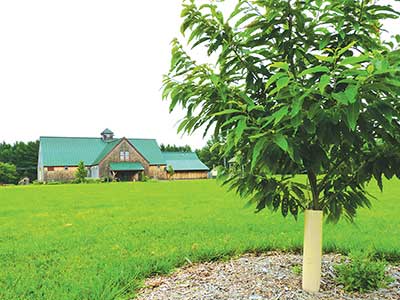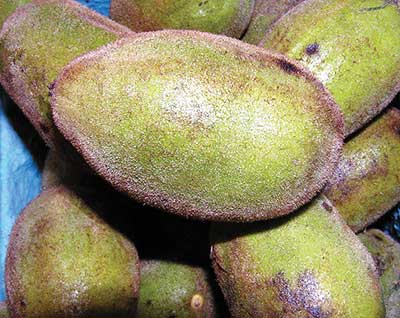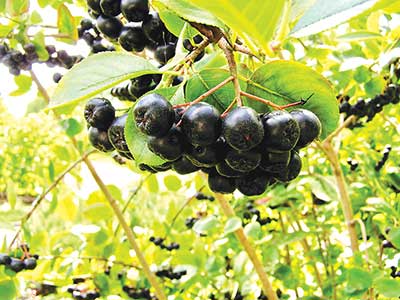 |
| A blight-resistant American chestnut tree growing at MOFGA’s Common Ground Education Center. |
 |
| Butternuts shown in the Exhibition Hall of the Common Ground Country Fair by Claudette Nadeau. |
 |
| Aronia melanocarpa growing at MOFGA’s Common Ground Education Center. |
Permaculture with a native twist
By Heather McCargo
Agroforestry is the practice of adding trees and shrubs to an agricultural system of traditional crops of vegetables, grains and livestock. Permaculture is agroforestry, with a focus on perennial crops, including herbaceous vegetables and woody plants that produce fruits, nuts or other edible products. Diversifying a farm with trees and shrubs not only produces a valuable harvest and shady foraging area, but also provides the ideal growing environment for high-value woodland medicinal herbs.
The three-dimensional growth of trees and shrubs has environmental benefits well beyond the crops. These include increased carbon sequestering in the above-ground vegetation, capturing and storing rainwater, reducing wind speed, and protecting the soil from erosion and temperature extremes in both winter and summer. While many wonderful cultivated woody crops from around the world can be grown in New England, this article focuses on our frequently undervalued native species.
In eastern North America many trees and shrubs produce delicious, edible fruits and nuts that can be harvested for people or foraged by livestock. Many valuable medicinal herbs and edible greens exist, also. Native plants are invaluable additions to a farm landscape because of the many ecosystem services they provide, such as food and habitat for indigenous species of birds, pollinating insects and the millions of kinds of microorganisms in native soil. This biodiversity significantly increases resiliency in the landscape.
Another benefit of native crops is that they are not demanding in their nutrient needs. Soil fertility is maintained with leaves, rotted bark and chipped branches, not the richer manures and composts that annual crops often demand. Because many of these native plants have not been domesticated, they can be grown from seed, which helps preserve the genetic diversity of the species (most cultivars are clones). While fruits of wild-type plants tend to be smaller, they are extremely flavorful and full of phytonutrients and other beneficial plant chemicals, including some with medicinal properties. Once established, these native plants are the ideal low-maintenance crops.
Below are two agroforestry systems using native species: first, a system with native tree canopy to shade livestock and produce a crop of fruits, nuts or other products; second, a system without livestock for cultivating an understory of medicinal herbs or green vegetable shoots shaded by the canopy and understory of trees and shrubs. Fencing is required in all agroforestry systems to contain desired farm animals, protect roos systems and herb plantings, and to exclude deer, whose rising populations are stressing all of our landscapes.
Creating a Canopy for Foraging Animals
Trees and shrubs create a cool, protective canopy for livestock such as turkeys, chickens, rabbits, sheep and pigs, which can also forage on the nutritious tree fruits that drop. Densely stocked animals can destroy tree root systems, so creating a woodland canopy for them requires a low stocking density and planting in islands or rows with fencing to control when the animals forage. Having several zones within foraging paddocks allows the vegetation to grow back after foraging. Plant a ground layer of herbaceous natives such as aster, goldenrod, partridge pea, switchgrass, beebalm, mountain mint, coneflower (Rudbeckia and Echinacea) and wild strawberry. See the Wild Seed Project website for more information on growing these native perennials and groundcovers.
Making Beds for Herbaceous Medicinal Herbs and Perennial Vegetables
In the shade of deciduous canopy trees, make a series of low raised beds edged with logs and amend the soil with lots of well rotted leaves. Composted leaves and aged deciduous (not conifer) bark are the best soil amendments for these plants. If your soil is very low in organic matter and nutrients, some compost can be added initially. Yearly mulching with leaves should meet the long-term nutrient requirements of these herbs. Edible and medicinal herbs that work well in this system include ramps, goldenseal, ginseng, black cohosh, blue cohosh, Solomon’s seal, ostrich fern, spicebush and witch hazel. Foraging livestock and wild deer must be fenced out of areas where these slow-growing, high-value species grow. For details see my article “Growing Ramps from Seed” in the winter 2016-2017 issue of The Maine Organic Farmer & Gardener. Wild Seed, the annual magazine of Wild Seed Project, ran articles on native edibles and medicinal plants in volumes 1, 3, 4 and 5. See https://wildseedproject.net.
Recommended Natives for Agroforestry
As with all planting projects, first assess the site conditions, especially sun exposure, soil type and moisture levels in spring and summer. Various native species thrive in hot, dry, sunny locations, in heavy, wet soils or in full shade. Match the plants to your site. If you have a sunny, hot site, don’t plan on raising woodland understory plants any time soon.
Below are native tree and shrub crops for various planting conditions. A few are available as cultivars with larger fruits or nuts, but the genetically diverse wild types are of high value in the landscape. All native trees and shrubs do best when established as young plants. Many annual plant sales offer native whips, which are best planted in early spring.
| Canopy Trees (40 to 100 feet tall) | Edible Part | Light | Soil |
| American chestnut, Castanea dentata (choose a disease resistant form) | nuts | sun to part shade | moist, well-drained |
| Basswood, Tilia americana | herbal flowers | sun to shade | moist, loamy |
| Black cherry, Prunus serotina | fruits | sun to part shade | moist to dry |
| Black walnut, Juglans nigra | nuts | sun to part shade | moist clay or loam |
| Butternut, Juglans cinerea | nuts | sun to part shade | moist |
| White oak, Quercus alba | nuts | sun to part shade | moist to sandy soils |
| Bur oak, Quercus macrocarpa | nuts | sun to part shade | moist to dry |
| Birch | bark and sap for syrups | ||
| Paper, Betula papyrifera | sun to part shade | cool, moist | |
| Yellow, B. alleghaniensis | part to full shade | cool, moist | |
| Black, B. lenta | full sun to part shade | moist | |
| Maple | sap harvest for syrup | ||
| Sugar, Acer saccharum | part to full shade | cool, moist, fertile | |
| Silver, A. saccharinum | part to full shade | wet to dry | |
| Red, A. rubrum | sun to part shade | wet to dry | |
| Shagbark hickory, Carya ovata | nuts | sun to part shade | well drained, medium to dry |
| Small Trees, Shrubs and Vines (with height noted) | |||
| Bayberry, Morella caroliniensis, 5′ | herbal leaves, nitrogen fixing roots |
full sun to part shade | dry |
| Black chokeberry | |||
| Aronia melanocarpa, 6′ | fruits | full sun, part shade | moist to dry |
| Blueberry | fruits | ||
| Highbush, Vaccinium corymbosum, 8′ | full sun to shade | moist, acidic | |
| Lowbush, V. angustifolium, 2′ | full sun to part shade | moist, acidic | |
| Dogwood, Swida alternifolia, 15′ | fruits for poultry | part shade | moist |
| Elderberry, Sambucus nigra, S. canadensis, 10′ | herbal flowers | sun | moist to wet |
| fruits | |||
| Hazelnut, Corylus americana, 8′ | nuts | sun to shade | moist to dry |
| Hawthorne, Crataegus sp., 15′ | fruits, herbal foliage, flowers | sun to part shade | moist to dry |
| Pawpaw, Asimina triloba, 15′ | fruits | part to full shade | moist |
| Redbud, Cercis canadensis, 15′ | edible flowers and pea pods | sun to shade | moist, zone 5 |
| Sassafras, Sassafras albidum, 20′ N.B.: The FDA bans sassafras oil for use in commercially mass-produced foods and drugs due to its potential carcinogenicity. |
herbal leaves and roots | sun to part shade | dry, zone 5 |
| Shadbush, Amelanchier canadensis, A. laevis, 20′ | fruits | sun to part shade | moist to dry soil |
| Spicebush, Lindera benzoin, 12′ | herbal foliage and fruits | part to full shade | moist to wet |
| Sumac, Rhus hirta, 15′ | fruits (poultry and seasonings) | sun | dry |
| Wild rose | |||
| Rosa caroliniana, R.virginiana, 5′ | fruits | sun to part shade | moist to dry |
| Viburnum | fruits | ||
| Highbush cranberry, V. opulus var. americanum, 12′ | sun to part shade | moist to wet | |
| Nannyberry, V. lentago, 12′ | sun to part shade | moist to dry | |
| Wild grape (on wire deer fence or arbor) | fruits, edible leaves | ||
| Vitis labrusca, V. riparia, 30′ | full sun to part shade | moist to dry | |
| Wild plum, Prunus sp. | fruits | ||
| Beach, P. maritima, 8′ | sun | dry well-drained | |
| Canada, P. nigra, 30′ | sun | moist to dry | |
| Witch hazel, Hamamelis virginiana, 15′ | medicinal bark | part to full shade | moist to dry |
Our native species are retreating as humans impact every corner of our world, including Maine. Add some native trees or shrubs to your farm or homestead. They will charm you with their beauty, resilience and delicious harvest.
Sources of Seeds or Plants
Fernwood, https://www.fernwoodnursery.com
Nasami Farm, https://www.nativeplanttrust.org/for-your-garden/nasami-farm/?highlight=nasami
Prairie Moon Nursery, https://prairiemoon.com
Wild Seed Project, https://wildseedproject.net
FEDCO, https://www.fedcoseeds.com/
About the author: Heather McCargo is executive director of The Wild Seed Project, a Maine 501c3 nonprofit organization that sells seeds of wild-type native plants and educates the public on propagation techniques to encourage increasing native plant populations. Visit its educational website at http:/www.wildseedproject.net/.

